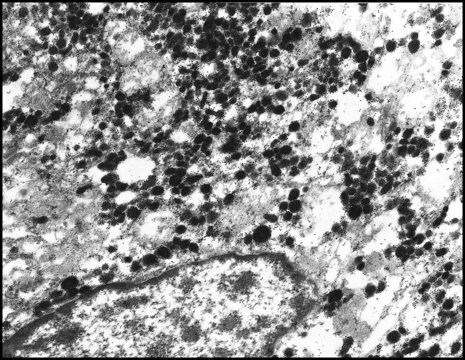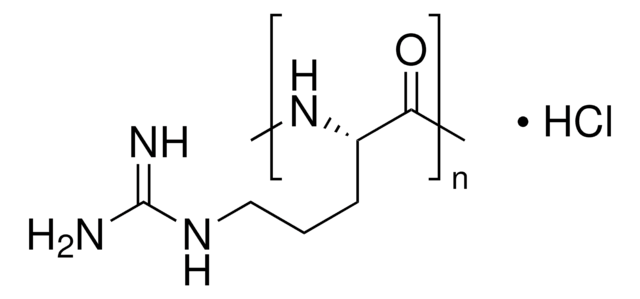G7527
Anti-Mouse IgG (whole molecule)–Gold antibody produced in goat
affinity isolated antibody, aqueous glycerol suspension, 5 nm (colloidal gold)
Sign Into View Organizational & Contract Pricing
All Photos(1)
About This Item
Recommended Products
biological source
goat
Quality Level
conjugate
gold conjugate
antibody form
affinity isolated antibody
antibody product type
secondary antibodies
clone
polyclonal
form
aqueous glycerol suspension
particle size
5 nm (colloidal gold)
storage temp.
2-8°C
target post-translational modification
unmodified
General description
The product binds to all mouse Igs.
Application
Anti-Mouse IgG (whole molecule)-Gold antibody produced in goat is suitable for use in Immunoelectron Microscopy at 1:20 dilution.
Biochem/physiol Actions
IgG antibody subtype is the most abundant serum immunoglobulin of the immune system. It is secreted by B cells and is found in blood and extracellular fluids and provides protection from infections caused by bacteria, fungi and viruses. Maternal IgG is transferred to fetus through the placenta that is vital for immune defense of the neonate against infections.
Other Notes
Antibody adsorbed with human serum proteins.
Physical form
Conjugate is suspended in Tris buffered saline, pH 8.2, containing 1% (w/v) BSA, 30% (v/v) glycerol and 15 mM sodium azide.
Disclaimer
Unless otherwise stated in our catalog or other company documentation accompanying the product(s), our products are intended for research use only and are not to be used for any other purpose, which includes but is not limited to, unauthorized commercial uses, in vitro diagnostic uses, ex vivo or in vivo therapeutic uses or any type of consumption or application to humans or animals.
Not finding the right product?
Try our Product Selector Tool.
Storage Class Code
10 - Combustible liquids
WGK
WGK 3
Flash Point(F)
Not applicable
Flash Point(C)
Not applicable
Personal Protective Equipment
dust mask type N95 (US), Eyeshields, Gloves
Choose from one of the most recent versions:
Already Own This Product?
Find documentation for the products that you have recently purchased in the Document Library.
Shankhajit De et al.
Diabetes, 66(5), 1391-1404 (2017-03-16)
Efficient biomarkers for diabetic nephropathy (DN) have not been established. Using ELISA, we found previously that urinary levels of full-length megalin (C-megalin), a multiligand endocytic receptor in proximal tubules, was positively correlated with DN progression in patients with type 2
Jens B Hafke et al.
Plant physiology, 162(2), 707-719 (2013-04-30)
This study dealt with the visualization of the sieve element (SE) cytoskeleton and its involvement in electrical responses to local cold shocks, exemplifying the role of the cytoskeleton in Ca(2+)-triggered signal cascades in SEs. High-affinity fluorescent phalloidin as well as
Benoît Zuber et al.
Proceedings of the National Academy of Sciences of the United States of America, 110(26), 10622-10627 (2013-06-12)
The scaffolding protein at the neuromuscular junction, rapsyn, enables clustering of nicotinic acetylcholine receptors in high concentration and is critical for muscle function. Patients with insufficient receptor clustering suffer from muscle weakness. However, the detailed organization of the receptor-rapsyn network
Caterina Mencarelli et al.
Cytoskeleton (Hoboken, N.J.), 70(8), 439-452 (2013-06-28)
The intraflagellar transport (IFT) system was first identified in situ by electron microscopy in thin sections of plastic-embedded flagella as linear arrays of electrondense particles, located between the B tubules of the outer doublets and the flagellar membrane. These arrays
Marianela C Serradell et al.
Nature communications, 10(1), 361-361 (2019-01-22)
Intestinal and free-living protozoa, such as Giardia lamblia, express a dense coat of variant-specific surface proteins (VSPs) on trophozoites that protects the parasite inside the host's intestine. Here we show that VSPs not only are resistant to proteolytic digestion and
Our team of scientists has experience in all areas of research including Life Science, Material Science, Chemical Synthesis, Chromatography, Analytical and many others.
Contact Technical Service








